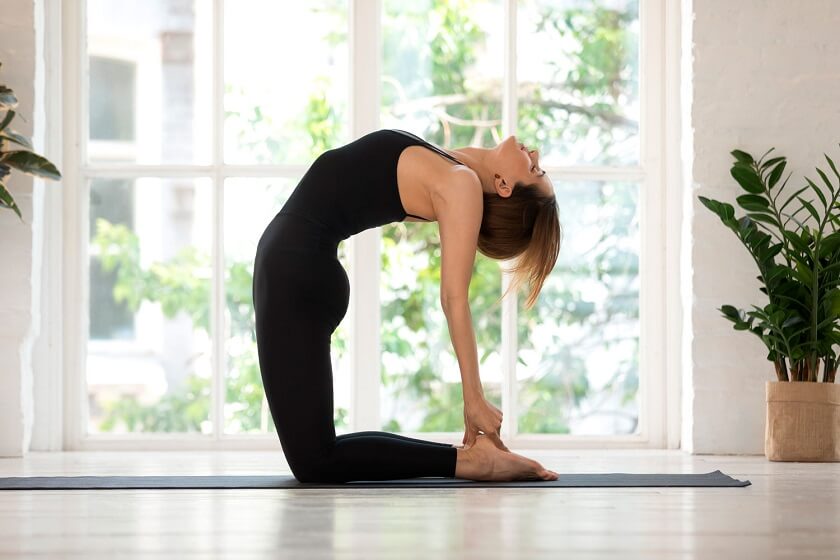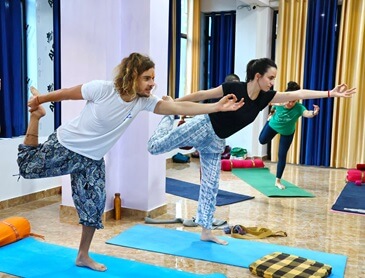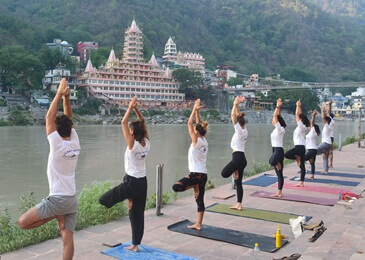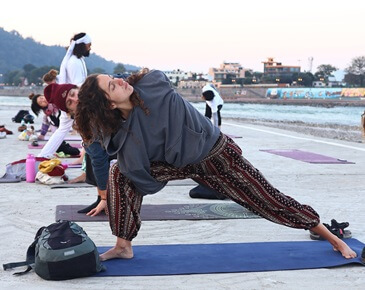
14 Aug. 2019
Ustrasana (Camal Pose) – Benefits, Adjustment & Cautions
Ustrasana (Camal Pose) In truth we are not sure why this asana is called the camel pose. It is difficult to imagine. We can hazard a guess and say that it is because the thighs, trunk and head resemble the neck of a camel. Ushtrasana is a reasonably simple asana which gives a wonderful stretch to the thighs, abdomen, ribcage and throat. Technique Place a blanket on the floor. Kneel and adjust the knees and feet so that they are separated by the same width as the hips. This ensures firmness and balance throughout the movement. The top of the feet should rest on the ground. In the starting position the thighs, trunk and head should all be vertical. Lean backwards slightly. Simultaneously turn to the right side and grasp the right heel with the right hand.
Straighten the arm, allowing the arm to support the weight of the body. Then square the body and grasp the other heel with the left hand. Allow the head to hang backwards. Try to relax your whole body, especially the back muscles. By utilizing the muscles of the back, gently push the thighs, pelvis and abdomen forwards; the back muscles should remain relaxed and the hands in contact with the heels. The more the back muscles are relaxed, the further one will be able to push the body forward. While making this movement, one will find that the compression of the back will increase, especially the lower back (lumbar vertebrae). Be careful not to strain. With practice and sufficient relaxation of the back muscles it will be possible to assume the final pose as shown in the picture above. Make sure the leg muscles are relaxed. The whole weight of the body should be supported at the knees; at first this may not be possible but with practice it will be easily achieved. The arms should bear no weight; in fact they act in the opposite sense. They should anchor the shoulders to maintain the arch of the back. In other words, the arms hold the shoulders down so that the flexion of the back can be accentuated; the arms do not hold the shoulders up.
Relax the muscles of the neck, legs, arms and back as much as possible. The optimum relaxation of the back is important, for this allows the upper part of the body to sag under the influence of gravity; this applies the best possible flexion to the back, without any muscular resistance. Breathe normally, allowing the arch of the back to accentuate during exhalation. Remain in the final pose for as long as comfortable. Then return to the starting position by tensing all the muscles and reversing the method we have already explained. Ensure that the body is supported and pivoted about one arm as the opposite side of the body is swung forwards. Do not hurry during this movement.
Beginners People with stiff backs may find this asana a little difficult at first. If this is the case, start the asana with the balls of the feet on the ground. This raises the heels and allows them to be more easily grasped by the hands. Some people will still find that they are unable to hold both heels at the same time. A method of gradually overcoming this problem is to merely reach back with one hand and grasp one heel. Hold this position for a second or so, release, twist the body and then grasp the other heel with the other hand. Repeat this alternate twisting movement a number of times. There should be no violent movements, only smooth, slow and relaxed ones. This simple exercise will help to loosen up the back so that one can eventually hold both heels.
Awareness and duration Maintain awareness of breathing and relaxation of the whole body. It is difficult to stay in the final pose for more than a few minutes. Aim at eventually maintaining the asana for up to two minutes. Initially, hold the final pose for no more than a few seconds, increasing the duration by a few seconds daily. Sequence This is a backward bending asana. As such it should follow or precede any of the asanas which bend the spine forwards.
Limitations Persons with severe back ailments such as lumbago should not attempt this asana without expert guidance. Those who suffer from an enlarged thyroid should also take care. Mistakes to avoid Often people allow the weight of the body to be supported on the arms and heels in the final pose. Although this does not cause any harm, it greatly reduces the efficiency of the asana. Another common error is to tense the back muscles, which prevents maximum flexion of the spine.
Try to relax the muscles as much as you are able. Do not breathe too deeply in the final position - the chest and abdomen are already stretched, which imposes restraint on breathing. Any attempt to breathe deeply could easily strain associated muscles. Benefits This asana applies a wonderful stretch to the whole chest and abdomen, at the same time imparting a thorough massage to the internal organs. As a result, it is useful for alleviating various abdominal ailments associated with the kidneys, pancreas, intestines, liver, etc.
Shallow breathing is often caused by inflexibility of the ribcage. Ushtrasana expands the ribcage and the associated muscles are made more supple. As a result deeper breathing is facilitated. The spine is given a wonderful backward bend, loosening up the vertebrae and stimulating the spinal nerves. The shoulders are pulled backwards while the chest is pushed forwards, helping to correct rounded shoulders and a stooping back. The front of the neck is fully stretched, applying a good massage to the nerves and organs in this region. In particular, the all important thyroid gland is regulated. Those people who suffer from backache, neckache or general stiffness in the spine will gain relief through regular practice of this asana.


